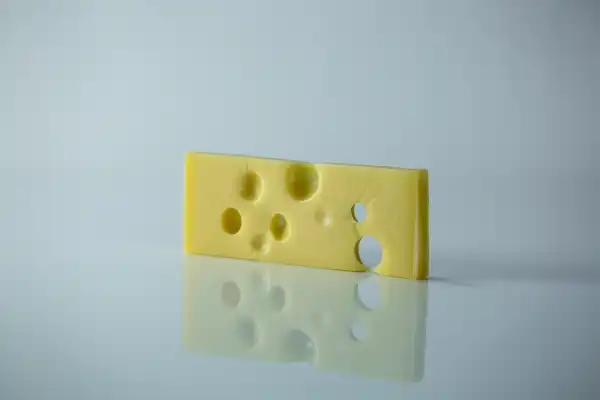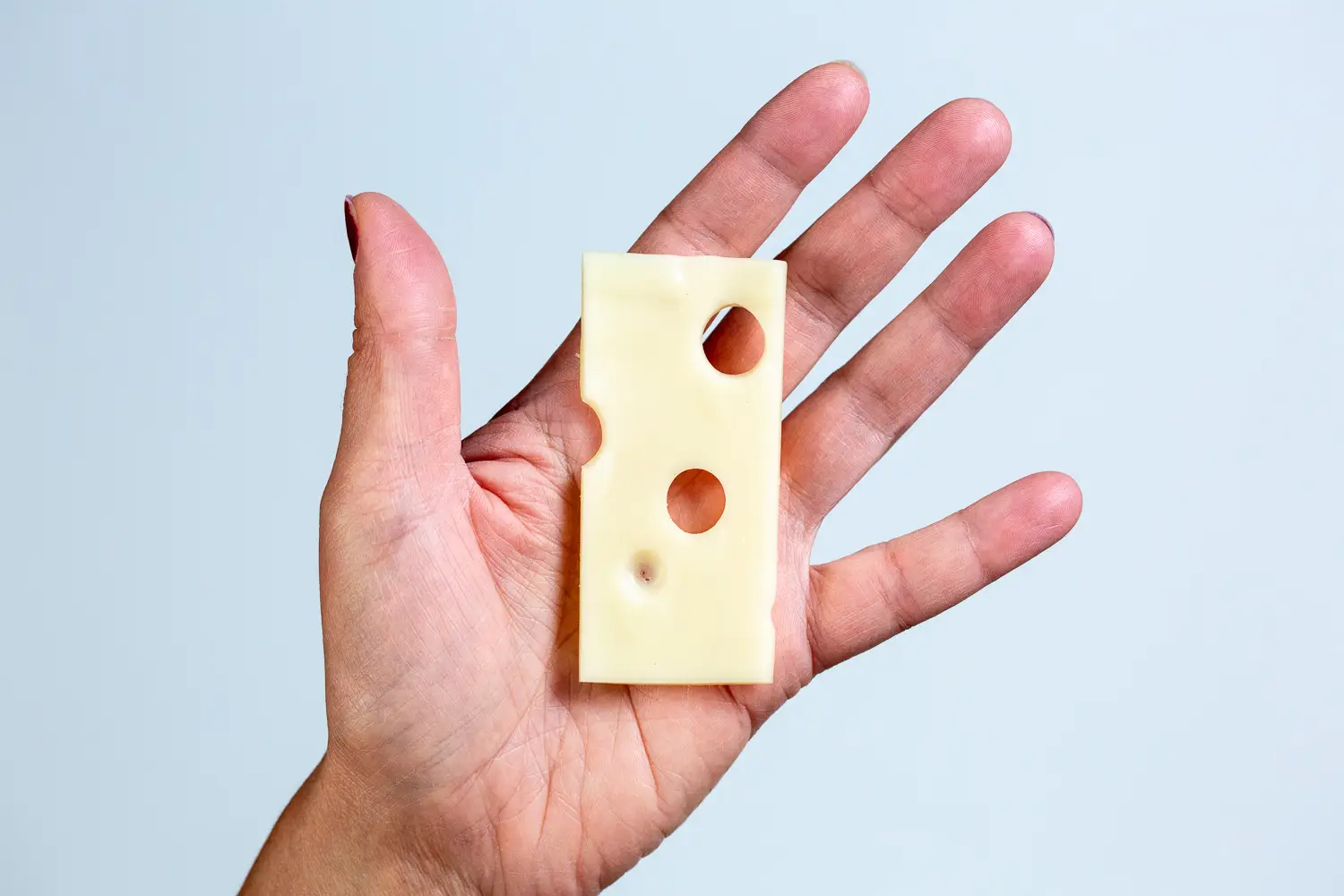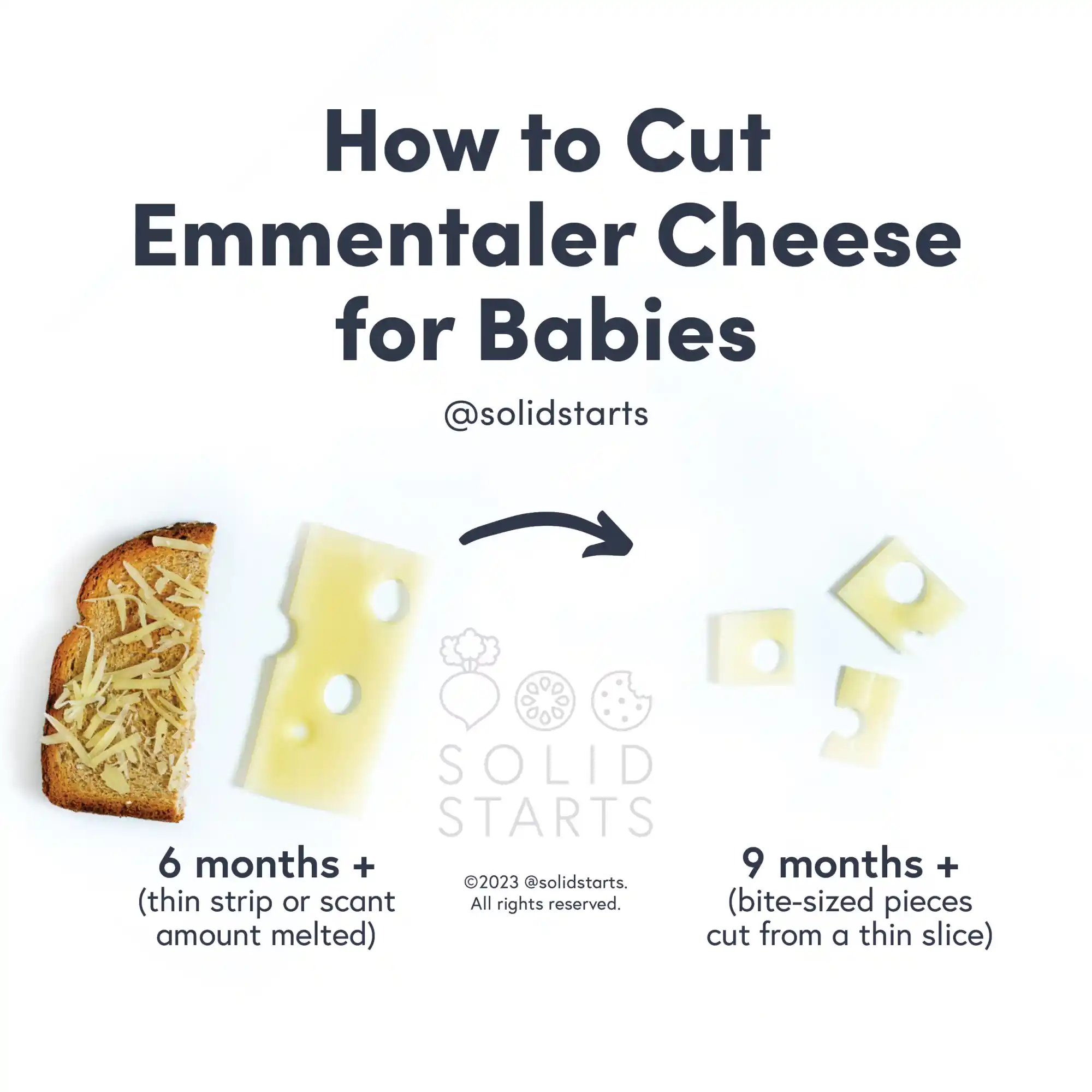Access our First Foods® Database in the Solid Starts App.
Learn moreEmmentaler Cheese
Dairy
Age Suggestion
6 months
Iron-Rich
No
Common Allergen
Yes

When can babies have emmentaler cheese?
Emmentaler cheese, when pasteurized, may be introduced as soon as baby is ready to start solids, which is generally around 6 months of age. Choose pasteurized emmentaler to minimize the risk of foodborne illness.
Emmentaler (also called emmental, emmenthal, or emmenthaler) is a firm cow’s milk cheese named after the alpine region in Switzerland. Emmentaler certified by Appellation d'Origine Protégée guarantees that the cheese was made with raw milk from pasture-raised cows in the Alps, while its look-alikes in the United States and beyond are typically made with pasteurized milk.
Learn more about choosing cheese to share with babies.
How do you serve emmentaler cheese to babies?
Every baby develops on their own timeline, and the suggestions on how to cut or prepare particular foods are generalizations for a broad audience.
6 months old +:
Offer pasteurized emmentaler cheese in long, thin slices, which both reduces the choking risk and makes it easier for babies to self-feed. Shredded emmentaler cheese can be melted into a variety of foods, but sprinkle sparingly, as large globs of melted cheese can be difficult for young babies to chew and manage in the mouth. Avoid offering any kind of cheese in cubes and large chunks.
9 months old +:
At this age, babies develop the pincer grasp (where the thumb and forefinger meet), which enables them to pick up smaller pieces of food. When you see signs of this development, you can move down in size, either to grated pasteurized emmentaler cheese or bite-sized pieces cut from a thin slice (continue to avoid cube shapes). Offer the cheese on its own, so baby can experience the flavor, or as part of a meal.
12 months old +:
Continue to offer grated pasteurized emmentaler or bite-sized pieces cut from a thin slice. Alternatively, move back up in size to longer, thin slices so that the toddler can practice tearing and taking bites. At this age, you can also melt the cheese over bread, tortillas, pasta, beans, or vegetables. Just make sure the cheese isn’t too hot, but also hasn’t cooled so much that it has become hard and clumpy.
24 months old +:
Serve pasteurized emmentaler cheese in thin slices or bite-sized pieces, as well as melted over bread, tortillas, pasta, beans, or vegetables. At this age, many toddlers may be ready to eat cubes of emmentaler cheese. Before serving cubes of emmentaler cheese, look for signs of mature eating skills, such as taking small bites with their teeth, moving food to the side of the mouth when chewing, chewing thoroughly before swallowing, and not stuffing food in their mouths.
Even when the child is exhibiting these skills, we recommend coaching the child. Only serve cheese cubes when a child is seated in an upright seat, actively engaged in mealtime, and not distracted. Demonstrate chewing a piece of cheese yourself by placing it in between your front teeth, biting down, moving the food to the side, and then chewing with your mouth open. Once you have chewed the cheese well, open your mouth to show the child how it’s broken down. Say “I moved it to my big strong teeth to chew it. It needs a lot of chewing.” Then, offer one cube of cheese for the child to eat. If they do not attempt to chew, hold off on attempting again for a few weeks. Remember, these skills take time, and it’s best to meet the individual child where they are at.




Want ideas for packed lunches? See 75 Lunches for Babies & Toddlers.
Videos
Is emmentaler cheese a choking hazard for babies?
Yes. Cheeses like emmentaler are firm and can get globby and hard to manage in the mouth, qualities that increase the risk of choking. To reduce the risk, prepare and serve emmentaler in an age-appropriate way. As always, make sure you create a safe eating environment and stay within arm’s reach of baby during meals. For more information on choking, visit our section on gagging and choking and familiarize yourself with the list of common choking hazards.
Is emmentaler cheese a common allergen?
Yes. Emmentaler cheese is often made from cow’s milk, which is classified as a Global Priority Allergen by the World Health Organization. It is an especially common food allergen in young children, accounting for about one-fifth of all childhood food allergies. Keep in mind that dairy products from other ruminants such as sheep, goat, and buffalo may provoke similar allergic reactions to cow’s milk dairy products. That said, there’s good news: milk allergy often disappears with time. Research shows that the majority of children with cow's milk allergy will outgrow it by age 6, and many babies with milder symptoms of milk protein allergy (which can show up as painless blood in stool) are able to successfully reintroduce cow's milk as early as their first birthday, with the guidance of their appropriate pediatric health professionals. Note: Aged cheeses generally contain histamines, which may cause rashes in children who are sensitive to them.
Milk is a common cause of food protein-induced enterocolitis syndrome, also known as FPIES. FPIES is a delayed allergy to food protein which causes the sudden onset of repetitive vomiting and diarrhea to begin a few hours after ingestion. This is termed acute FPIES. Left untreated, the reaction can result in significant dehydration. When milk is in the diet regularly, FPIES can present as reflux, weight loss, and failure to thrive - this is termed chronic FPIES. Symptoms generally improve with elimination of milk from the baby’s diet. Thankfully, like other forms of milk allergy, FPIES which presents early in life is generally outgrown by the time a child has reached 3-5 years of age.
Lactose intolerance, which is when the body has a hard time processing lactose, the sugar that is naturally present in milk, can sometimes be mistaken for an allergy, as it can result in bloating, gas, diarrhea, nausea, and other discomfort. For those with older children who are lactose intolerant (keep in mind this is uncommon for infants and toddlers), some good news: compared with milk and certain other dairy products, many cheeses may be better tolerated by those with lactose intolerance, particularly aged cheeses, which have lower lactose content. Be sure to connect with an appropriate pediatric health care professional for any questions about lactose intolerance, and know there are many lactose-free dairy foods available.
If you suspect baby may be allergic to milk, consult an allergist before introducing dairy products like cheese. Based on a baby’s risk factors and history, your allergist may recommend allergy testing, or may instead advise dairy introduction under medical supervision in the office. If the risk is low, you may be advised to go ahead and introduce cheese in the home setting. As with all common allergens, start by serving a small quantity on its own for the first few servings, and if there is no adverse reaction, gradually increase the quantity over future meals. If you have already introduced milk and ruled out an allergy, pasteurized cheeses can be introduced as desired, without any need to start small and build up over time.
Is emmentaler cheese healthy for babies?
Yes. Emmentaler cheese is rich in protein, fat, calcium, selenium, zinc, and vitamins A and B12. Together, these nutrients work together to provide the building blocks for growth, development, and brain function. They also help support bone density, taste perception, vision, energy, and immunity. Choose pasteurized emmentaler cheese to minimize the risk of foodborne illness.
When can children eat unpasteurized (raw) emmentaler cheese?
There is no age at which eating cheese made from unpasteurized milk is without risk, which makes this a personal decision for you and your family based on your circumstances. While unpasteurized/raw cheeses are consumed by children in many parts of the world, eating these cheeses carries a significantly increased risk of foodborne illness, to which babies, young children, children with sickle cell disease, and immunocompromised individuals are more susceptible. Several national and international organizations, including the U.S. American Academy of Pediatrics, American Medical Association, Centers for Disease Control and Prevention, Food & Drug Administration, International Association for Food Protection, and the World Health Organization, strongly advocate for only consuming pasteurized milk and milk products for children and adults alike.
Our Team
Written by
Expert Tips Delivered to Your Inbox
Sign up for weekly tips, recipes and more!
Copyright © 2026 • Solid Starts Inc








